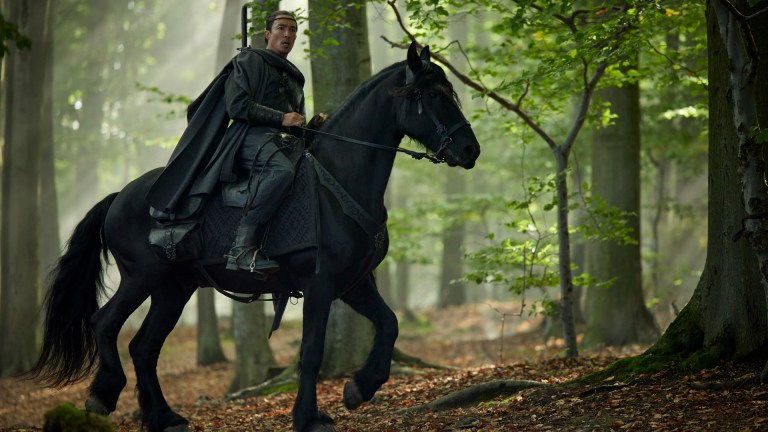The Wheel of Time Succeeds Where Lord of the Rings: The Rings of Power Failed
An attention to detail helps elevate The Wheel of Time over its Amazon Prime Video fantasy cousin.

This article contains spoilers for The Wheel of Time season 2 episodes 1-3.
With its half-a-billion dollar price tag, Prime Video’s The Lord of the Rings: The Rings of Power was meant to be the big event series of 2022, billed as the next Game of Thrones. Instead, it lacked critical and commercial acclaim. With the outstanding source material behind it and credible actors in front of the camera, there was enough intrigue to draw viewers in, but it lacked in visual grandeur and details that would’ve elevated it into something more, something better. Meanwhile, a year prior, the same streaming service debuted another adaptation of a popular fantasy series, The Wheel of Time. The series, adapted by Rafe Judkins, succeeded where The Rings of Power failed to deliver, resulting in a superior fantasy saga.
The Wheel of Time and The Rings of Power bring with them well-developed and recognizable characters to fans. Readers know these worlds and the diverse and rich backgrounds of the inhabitants of them. However, even while The Rings of Power was based off a hodgepodge selection of Tolkein writings rather than a singular novel or short story, it, along with The Wheel of Time and other series like it, had a due diligence to prove why the story needed to be adapted to screen in the first place. As a visual medium, television offers something that books can’t through sound and pictures. What elevates a good adaptation is the ability to infuse intent into the screen and to show how the creators are able to breathe further life into these worlds.
The adaptation of The Wheel of Time allows a dense saga to become more palatable for the television format. The Wheel of Time season 1 had its ups and downs (most notably a green cast who have grown into their roles in season two) but was still able to capture and maintain the sense of magic the novels first deployed. Overall though it was able to build the immense world and further enriched it through the design — costuming and sets, mainly — and by diversifying the cast to better represent the world in which the series is set in.
The Wheel of Time Pays Attention to Detail in Costuming
The ways in which the series establishes place, reign, and role are seen immediately in how they define, dress, and depict the ageless serenity of the Aes Sedai. As women who can channel the One Power (the elemental source that runs concurrently in this world,) they’re divided into seven different “Ajah’s” — placements that express their goals and prolific actions — coded by color, yellow, blue, red, green, gray, brown, and white. The Red Ajah hate men and are effectively the police of the organization, capturing men who are able to channel. Their outfits are militaristic, and leather bound, a stark contrast to the Blue Ajah, such as Rosamund Pike’s Moiraine. The Blue Ajah seeks justice, with an enormous network of informants around the world. Accordingly, Moraine often dresses best to benefit the nature of her surroundings, always with a piece of regality that puts her slightly out of step with those around her.
Members of the battle-ready Green Ajah are known to bond as many Warders as they please. The Aes Sedai Alanna mainly represents that group and her charisma and wily nature are channeled into her outfits, loose fitting to engage in the lack of rigidity of her Ajah while also showing the hardness of their nature in the jewelry adornments and metallics she wears.
There’s thought and precision that goes into each costume, each set piece, that makes it feel worn and ready for use. Meanwhile, Rings of Power season 1 suffered due to a lack of cohesion in the costuming, along with a few distinguishing items to establish the setting and space. While it makes sense for a dwarf to be dressed in gold, it’s nonsensical for an elf to do the same, with the lore pushing them more towards silver or mithril. It’s a small element for a casual viewer but those are the small touches and grace notes that help in meticulous worldbuilding, something a series, especially a fantasy series with so many realms and characters, necessitates.
That lack of consideration can be seen in the armor worn by humans and elves in the series that possesses as much dexterity and durability as styrofoam. One small part of the success of the original The Lord of the Rings trilogy was its artisans’ ability to convey weight and texture through costumes. When the characters stand their ground at Helms Deep the fatigue is palpable due in part to the heavy, realistic costumes the actors were wearing, believably waterlogged.
The creature, armor, and weapons art director of the original Peter Jackson trilogy, Kanye Horsham, along with his crew, created chainmail shirts that contained 80,000 rings, woven and linked by hand. That level of painstaking detail — for pieces of armor that may appear only for a second onscreen — is notably absent in The Rings of Power.
The Wheel of Time Season 2 Gets Important Characters Right
The Wheel of Time, meanwhile, demonstrates a clear respect and love for the series it’s adapting, going further than simply relying on budget. This is most notable in season two with the introduction of the Seanchan, a civilization that will prove to be one of the main antagonists to our heroes. Having traveled from across the sea, they’re immediately distinguishable from the characters we’ve met, their culture different and foreign to the ones we’ve come to know about. The Seanchan operate under the doctrine of enslaving those who can weave — channelers of the One Power — calling them “damane” and treating them like animals.
The costumes visualize that. While the captured channelers have their mouths obstructed those in rule, namely, the Empress, have their eyes shielded but are given the right to speak freely. It’s both a play on the idea of “see no evil” as they don’t observe their enslaving of women as wrong, believing channelers beneath them while also being a striking reminder of their power and corruption. The effect is beautifully unsettling, especially as we watch the violence they wreak against any and all deserters.
They, along with the Aiel, are the two major groups being introduced in season two and both were inspired by different cultures throughout history. The marriage of historical references along with the fantastical setting come together to create something eerie and out of time., Something often forgotten with The Wheel of Time is that this world is set in post post-apocalypse, rather than in a pre-modern world. There’s a deliberate mesh of cultures, power rankings, infrastructure, and architecture. The clothing is piecemeal, touched with modernism and history.
The Rings of Power Struggles With Set Design
Similarly the set design is just as crucial to crafting the overall feel of The Wheel of Time. Take, for instance, The White Tower where many Aes Sedai reside. The architecture blends European and South East Asian influences, showcasing foundations from a world before the breaking, transformed into something new and different. A focal point to the series and a place where many casual inhabitants of the world fear, it’s built to be opulent, but cold.
The wide, arching windows offer the manifestation of the literal “eye of the world” in which the Aes Sedai look through due to their power and influence. Compare that to The Rings of Power where, despite the lavish costumes, Khazad-Dûm — the home of dwarves Durin and Disa — possesses no spark of life. Instead it, like so many mainstream blockbusters today, adopts a grayness to its aesthetic, something that doesn’t create something timeless but something so without distinction that it could reside anywhere.
Both the world of J.R.R. Tolkien and Robert Jordan’s Wheel of Time series share rich, dense, lore but the Wheel of Time television adaptation is the only one of the two that proved as much. While Rings of Power was able to establish different places and civilizations through the visual understanding of elves, dwarves, and humans all living in separate divisions of Tolkien’s world, Wheel of Time needed to achieve the same effect with a largely human cast.
The Wheel of Time is what The Rings of Power wanted to be. The latter lacks any visual spark or imagination. Not every Wheel of Time actor settled immediately into their roles, needing to shake off stiff line delivery as many dealt with the first, major leading role. Despite this, it delivers a story that is enlivened through a world that’s been suitably enriched and brought to life through the minds behind the series. The show honors the source material while visually making sure areas and fractions are distinguishable enough so that non-book readers are able to follow along.
The first three episodes of The Wheel of Time season 2 are available to stream on Prime Video now.
